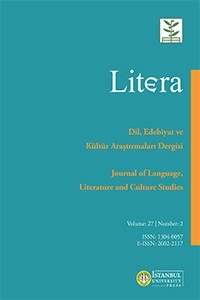The Ambiguity of Chinese Joke “Xiehouyu”: A Research Based on Sigmund Freud’s Joke Theories
The Ambiguity of Chinese Joke “Xiehouyu”: A Research Based on Sigmund Freud’s Joke Theories
This article analyzes Xiehouyu – a kind of Chinese proverb created by Chinese working people since ancient times. Xiehouyu consists of two parts. The former segment serves as a riddle for the addressee, the latter part acts as the answer. One would often only state the first part, expecting the addressee to grasp the true meaning of the sentence by himself. Xiehouyu falls into two main categories: Xiehouyu with multiple use of the material and Sound-Xiehouyu. Xiehouyu is similar to jokes in that its mechanism of pleasure can also be effected by ambiguity. Sigmund Freud’s theories from his joke research therefore apply to the analysis of Xiehouyu. In the rhetorical dimension, using the same word with multiple meanings or using two similar/ identical sounding words of varying meaning, Xiehouyu creates the “saving”, and thus in the psychical dimension, the pleasure mechanism of Xiehouyu works by relief from “psychical expenditure” that is already there, and economizing in psychical expenditure that is only about to be called for. The pleasure effect of Xiehouyu depends on the third person, namely the listener, who should hold an indifferent feeling against the second person, in other words, the laughter target. Over time, many old phrases of Xiehouyu have gone out of use, while new ones have continuously emerged in the course of industrialization and globalization. Consequently, modern Xiehouyu and western jokes share more similarities than before, making it easier for people with different cultural backgrounds to understand each other’s jokes.
Keywords:
: Xiehouyu, joke, ambiguity, Sigmund Freud mechanism of pleasure,
___
- Austin, J.L. (1977). How to Do Things with Words. Oxford, UK: Oxford University Press.
- Bernt, F. (2009). Amphibolie – Ambiguität – Ambivalenz: die Struktur antagonistisch-gleichzeitiger Zweiwertigkeit. Würzburg, DE: Königshausen & Neumann.
- Bergson, H. Das Lachen: Ein Essay über die Bedeutung des Komischen. Darmstadt, DE: Luchterhand.
- Best, O. F. (1989). Der Witz als Erkenntniskraft und Formprinzip. Darmstadt, DE: Wissenschaftliche Buchgesellschaft.
- Butzer, G., Joachim Jacob (Hrsg.). (2012). Metzler Lexikon: literarischer Symbole. Stuttgart, DE: J.B.Metzler.
- Cheng, F. (1984). 古今歇后语拾遗兼注 [Annotated and Supplemented Collection of Old and Modern Xiehouyu]. Beijing, China: Nongcun Verlag.
- Freud, S. (1958). Der Witz und seine Beziehung zum Unbewusstsein. Frankfurt am Main, DE: Fischer Bücherei.
- Kotthoff, H. (1998). Spaß Verstehen. Zur Pragmatik von konversationellem Humor. Tübingen, DE: De Gruyter.
- Macha, J. (1992). Sprache und Witz: die komische Kraft der Wörter. Bonn, DE: Dümmler.
- Preisendanz, W. (1970). Über den Witz. Konstanz, DE: Universitätsverlag.
- Raskin, V. (1985). Semantic mechanisms of humor. Reidel, DE: Dordrecht.
- Röhrich, L. (1977). Der Witz: Figuren, Formen, Funktionen. Stuttgart, DE: Metzler.
- Wiethölter, W. (1979). Witzige Illumination: Studien zur Aesthetik Jean Pauls. Tübingen, DE: Niemeyer.
- Başlangıç: 1954
- Yayıncı: İstanbul Üniversitesi
Sayıdaki Diğer Makaleler
Language Innovation in the German Migration Discourse
Lehçede Söz Türetme Yöntemlerine Genel Bir Bakış
Aidiyetsiz Kahramanlar: Milan Kundera’nın Bilmemek Romanında Çoksesli Anlatı
Fatma AKBULUT, Bülent ÇAĞLAKPINAR
The Ambiguity of Chinese Joke “Xiehouyu”: A Research Based on Sigmund Freud’s Joke Theories
